$217 million plan would reshape downtown KC with park, attractions over busy highway
- Oops!Something went wrong.Please try again later.
Put a lid on it.
That was landscape architect Chris Cline’s first thought when, on a Friday in October 2004, he and HNTB colleague Todd Achelpohl were brainstorming how to further redevelop downtown Kansas City’s south loop area — where Interstate 670 cuts through downtown and separates it from the Crossroads.
Then-Mayor Kay Barnes wanted more ideas on how to keep up the momentum after voters had approved financing for the downtown arena she’d championed. The downtown Power and Light entertainment district was beginning to take shape and Julia Irene Kauffman was raising money to build a concert hall near 16th Street and Broadway Boulevard.
What else? What next?
“Todd came over to my desk,” Cline recalled recently, “and asked, ‘What are we going to do about the freeway? And should we look at expanding over in the Crossroads.’
“And I said, ‘yeah, we should look at a deck park.’”
That was the light-bulb moment for the $217 million plan now in the works to cap a four-block stretch of I-670 and build a park there.
A lot of people loved the idea then of hiding the highway that was 20 feet or more below street level. A lid would shut out some of that noise and reconnect downtown with the Crossroads to its south.
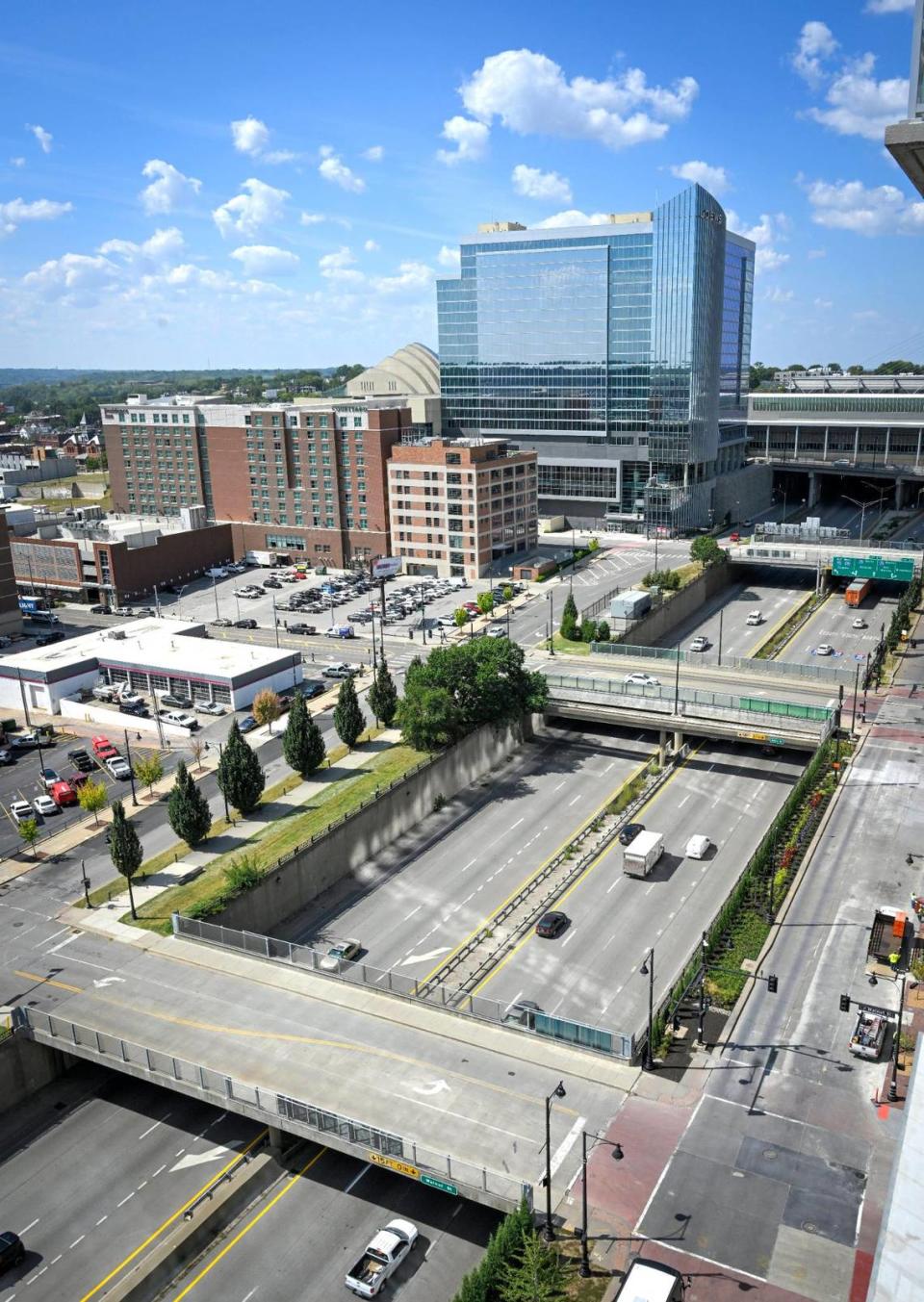
Yet for the better part of the last two decades, the Big Lid seemed like one of those blue-sky projects that was never going to happen.
Of all the plans collecting dust at City Hall, who’d have thought this one would finally find legs?
“I’ve been a little bit surprised to see that it’s stuck around as an idea,” said Achelpohl, now an adjunct professor at the University of Kansas.
But thanks to significant financial support from the city, state and federal governments — funding from President Joe Biden’s infrastructure bill with crucial support from now-retired Sen. Roy Blunt got the fundraising going — the South Loop Project was off and running.
Along with the $68 million in tax dollars secured so far, a robust private financing campaign is underway with a goal of non-governmental donations covering 40% of the project cost.
Once more money rolls in, construction could begin next year and Kansas City could begin to reclaim a chunk of real estate lost when the freeway trench was dug 60 years ago to make way for what was then known as the Crosstown Freeway.
“It’s a reclamation project,” said Bill Dietrich, president and CEO of the Downtown Council of Kansas City, which has been pushing the South Loop project since HNTB pitched it 19 years ago.
“It’s kind of healing an old wound,” he said. “We’re reconnecting neighborhoods.”

The original idea for a big lid was different than the one now being discussed. Cline and Achelpohl proposed realigning Truman Road to create a leafy boulevard down the middle of the freeway lid. New office buildings and apartments would have risen on either side of it, where Truman’s traffic lanes are today.
Although park-like, Truman Boulevard was not envisioned as a park.
However, the overarching goal was the same then as now, said Jon Stephens, president and CEO Kansas City’s port authority.
“It’s a big piece of infrastructure that will have a pretty big transformational impact,” Stephens said in an interview.
‘It’s criminal’
He and the staff at PortKC are coordinating the South Loop Project. For several years, Stephens has been on a mission to correct what he sees as the sins of past policymakers who tore down 1,100 buildings to make way for the south leg of the downtown loop alone.
“It’s criminal,” Stephens said, “that we destroyed so much housing to turn into all these highway systems.”
At a presentation last year for the Linda Hall Library, he framed it this way:
“This is not a park project. The South Loop is an active reclamation of space for all Kansas Citians. It will be a call to action for healing the wounds created by our highway system throughout the urban core.”
The average person, however, will no doubt experience the Big Lid for the park that it will become when, if everything goes according to plan, the first portions of it begin to open in the summer of 2026 as the World Cup is set to get underway.
“We’re going to build it, in essence, block by block,” Mayor Quinton Lucas told The Star. “Building it out that way, you’ll have a substantial portion of it (built by then). But I never want to over promise.”
Among the planned amenities on those five acres: a dog run, food hall, event space, playgrounds, walking trails and plenty of attractive green spaces to hang out, catch some rays or spread out beneath shade trees and watch office workers, downtown residents and tourists stroll by.
“It’s going to become a kind of local, regional and statewide draw,” Dietrich said. “I think it’s going to be a huge amenity for the people who live downtown and work downtown.”
But before the pretty renderings displayed on the project’s website can become reality, much work remains.
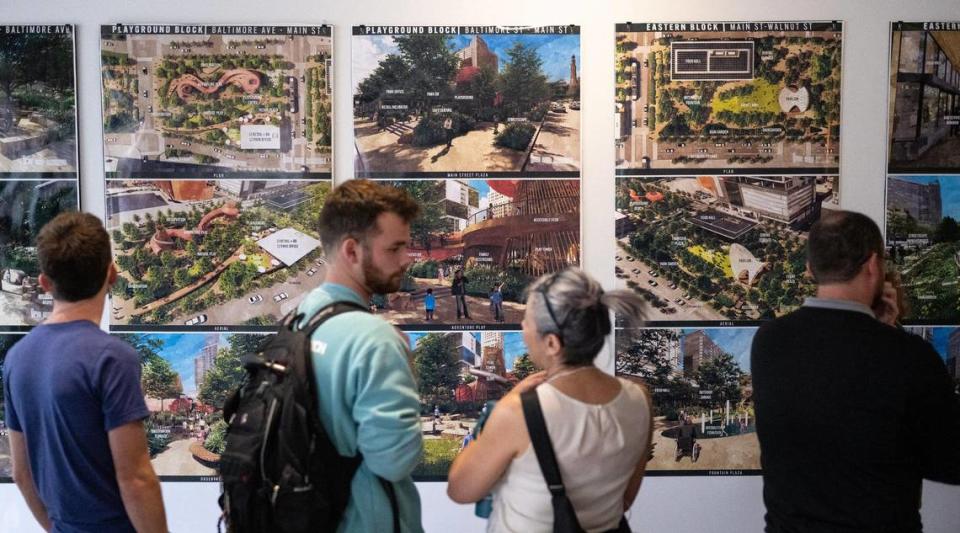
Designers are still working out the engineering challenge of creating a deck park over a space with the steep slope this one will have at its western end.
Federal and state agencies need assurances that the tunnel that the lid creates will be structurally sound and not present safety problems for the traffic below.
And then there’s the fundraising. A sprint is on to raise the tens of millions of dollars still needed for the project to get the green light to begin construction.
But after two decades of fits and starts, community leaders are confident that all those challenges will be met and that the Big Lid will be built and demonstrate that Kansas City can still do big things.
“I think Kansas City is finally learning how to be a big city,” said Morgan Said, Mayor Lucas’s chief of staff. “What I mean by that is consolidating around massive projects that no one thinks will happen, but you know it can happen and really leveraging our philanthropic partners in a strategic way.”
Too often, she said, the city has taken “a Band-Aid approach” to achieving big goals.
“I think now we’re to a place where we’re like, no, we deserve nice things.”
Plan sat on the shelf
Seattle was the first to build a park atop a freeway in 1976. Boston embarked in the 1980s on an expensive project to put its downtown freeway system underground.
Since then, freeway lids of varying sizes, scope and purpose have been built in cities such as St. Louis, Phoenix, Washington, D.C., and Denver. Many others are planned.
Kansas City has done it before by capping two blocks over I-670 for Bartle Hall’s expansion in 1994, and the idea of covering more of the south loop was kicking around even before Cline and Achelpohl had their bright idea.
“When I was in college at K-State, back in 2000, we had that as one of our design projects, as a big idea,’’ said landscape architect Chris Handzel, who is now an associate vice president at HNTB, the firm that designed the sunken freeway and is now heading up the project to put a lid over it. He’s the team leader.
“I’m very excited about it. It’s a once in a lifetime opportunity to be involved in it,” he said.
Handzel joined the Kansas City-based design firm in 2005, the same year U.S. Rep. Emanuel Cleaver secured a $1 million grant aimed at fleshing out Cline and Achelpohl’s sketches. He went on to become the deputy project manager in 2007 for that feasibility study and helped produce the 306-page report that came out in December 2009.
It proposed a lid park stretching all the way from Bartle Hall to Oak Street, two blocks longer than the current proposal.
“It was the worst possible time, in 2009, to come out with a big project like this,” Handzel said, “and then it sort of sat on the shelf for awhile.”
With Kansas City and the rest of the globe in the midst of the Great Recession, there was no appetite locally for a grand and seemingly extravagant amenity like a freeway park. The city’s federal stimulus dollars went to build sidewalks, winterize homes and improve mass transit.
But then in 2017, with the local economy doing well again, the lid study came off the shelf and a Kansas City delegation of business and political leaders visited Dallas to see what might be possible.
With $110 million in public and private dollars, Big D’s movers and shakers had done what Kansas City leaders had only dreamed of doing. They built a five-acre deck park over the eight-lane Woodall Rodgers Freeway, which is the north leg of Dallas’ downtown loop.
Named after the son of the Texas billionaire who gave the largest private donation, Klyde Warren Park opened in 2012 and is credited with spurring millions of dollars in private development inside and outside the downtown loop.
“Klyde Warren Park created green space ‘out of thin air,’” the park’s website says, attracting 1 million visitors a year for festivals, yoga classes, kids activities or just grabbing a bite at the food trucks that congregate there.
So popular has it become that the foundation formed to run the park has embarked on a fundraising campaign to enlarge the park by another 1.7 acres at a cost of $100 million.
“That’s really kind of when we got reinvigorated,” Handzel said of that Dallas trip six years ago.
But it wasn’t until the end of 2022 that the project began to take off. That’s when the federal government came through with $28.6 million for the lid. South Loop Project leaders credit Blunt with securing that crucial chunk of money.
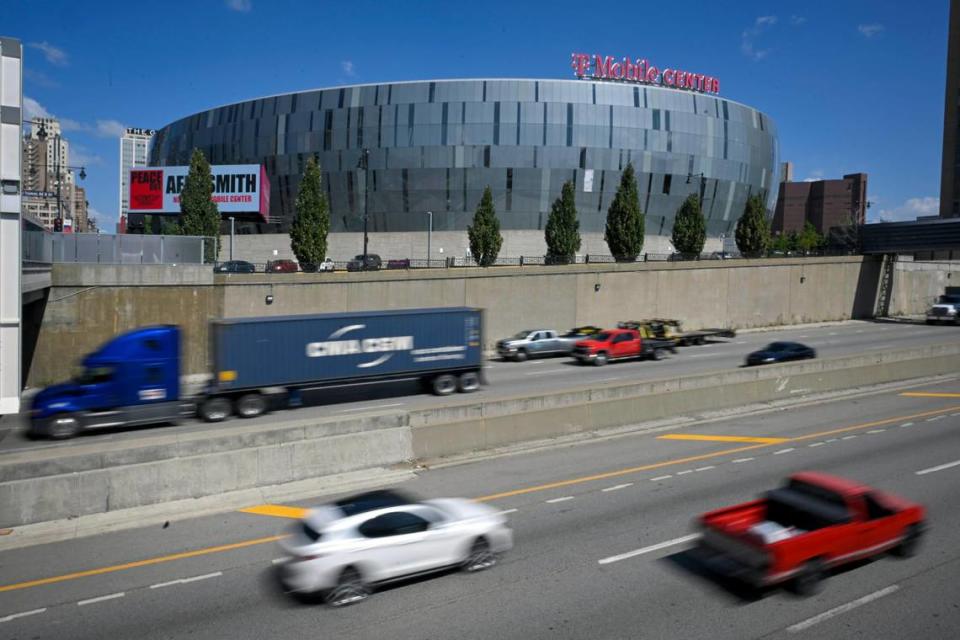
It’s no coincidence that Blunt was one of 19 Republicans in the 50-50 Senate to break with their party and support the Democratic administration’s $1.2 trillion infrastructure package from which the lid funding came.
“That was a huge step in going forward,” Lucas said.
With Gov. Mike Parson’s support, Missouri matched that amount, and the city kicked in $10 million.
More than $18 million in private donations have also come in, led by H&R Block and the associated Marion and Henry Bloch Foundation, which together gave the largest gift so far of $10 million.
H&R Block CEO and president Jeff Jones is the fund-raising co-chair. He is confident that the other $72 million in private donations will be in hand before long.
“We wanted to make a leadership gift so as co-chair I could confidently say we’re putting our money where our mouth is,” Jones said. “I want to challenge other companies, challenge other civic leaders, challenge other foundations in that this is really the beginning of what I call the next phase of the rise of Kansas City.”
Design challenges
The park will be built atop a series of concrete decks, supported by box beams that will span the eight-lane highway below to the retaining walls on either side.
Columns rising from the highway median strip, much like the ones beneath Bartle Hall, will provide further support.
The engineering is similar to that of the Dallas freeway park, which is supported by more than 300 concrete beams.
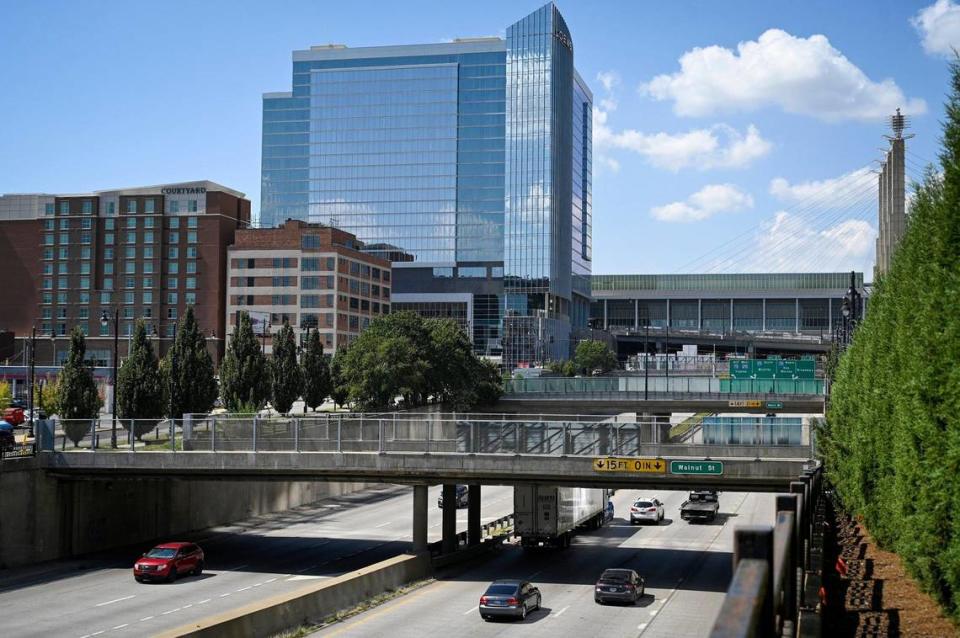
According to Architectural Record magazine, the beams alternate with 4.5 foot deep concrete trenches for trees, plumbing and electrical equipment.
“The trenches act like planter boxes, allowing the trees to grow to the desired size,” the Klyde Warren website said. “A combination of Geofoam and specially-designed soil helps keep the deck from being too heavy.”
Handzel said the Kansas City deck will be 42 inches deep in most areas, but up to 4 feet where trees will be planted. Much deeper and the deck wouldn’t be able to support the weight of the soil and everything on top of it.
“Our team has soil scientists on board right now that are just now starting to look at what is the perfect mix of soil to make sure that these plants survive in our climate and reduce the total weight of that system such that the structure can easily support it,” he said.
Likewise, any buildings constructed on top of the deck, such as the food hall, park offices and rest rooms, would be built largely from wood, which is lighter than stone or concrete.
The same landscape architecture firm that designed the features for Klyde Warren Park in Dallas and Gene Leahy Mall at the Riverfront, which is Omaha’s new downtown park, has been working on designs for Kansas City’s freeway park.
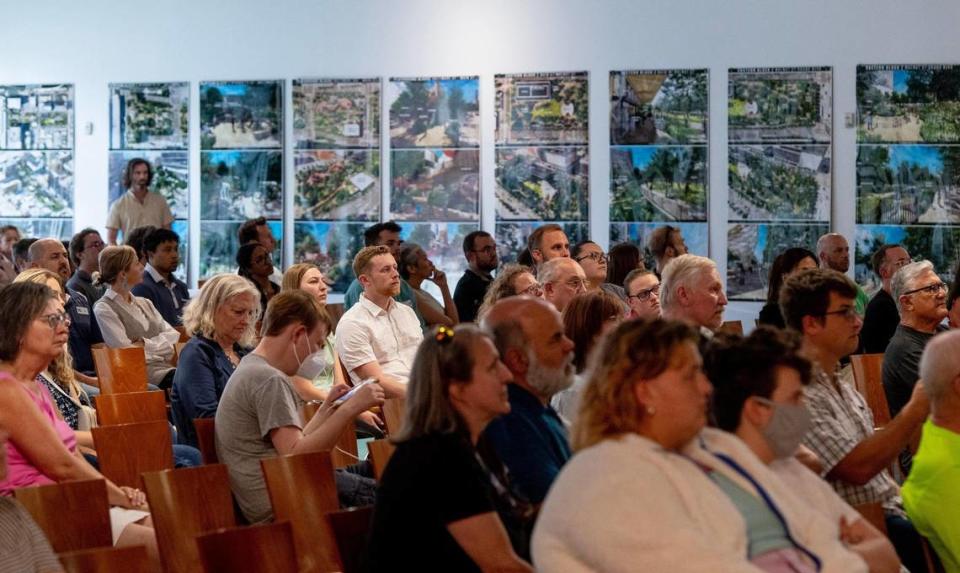
At a public forum last month, Nathan Elliott of OJB Landscape Architecture, said this project presents a challenge the other two didn’t. Both are fairly flat, but this one will be built at a slope.
“One of the biggest and most challenging things about this project, aside from being built over freeway, is the fact that there’s a significant amount of grade change that happens just in these four blocks,” Elliott said.
There’s a 35 foot drop between Wyandotte Street, the proposed park’s western border, and Baltimore Avenue one block to the east. From Baltimore to Main Street, the grade falls 12 feet, then another 10 feet to the low point at Walnut Street, then it rises 10 feet to the eastern boundary at Grand Boulevard.
“That’s a lot of grade change,” Elliott said. “So it’s made both an interesting design challenge, but it’s yielded some really fun solutions.”
One would be to turn the hilliest block, Wyandotte to Baltimore, into a wooded “refuge;” the space between Baltimore and Main into a playground area and the two eastern blocks into a place for bigger events by closing the Walnut Street bridge to vehicle traffic.
But nothing’s certain yet. There will be another forum early next year and, by that time, the project’s leaders hope to have some important answers to the engineering questions they’re exploring, as well as have a better handle on funding.
“We feel that we’re on schedule and that we’re on pace,” Stephens at PortKC said.
Jones sees the park becoming an important addition that could spark other development in a downtown that has seen a lot of change since the lid was proposed all those years ago.
“It’s the adjacent economic development that tends to follow these projects,” he said. “You put together the Power & Light District, this park, a (possible) baseball park, and that is an increasingly catalyst to continue to help the city rise.”

